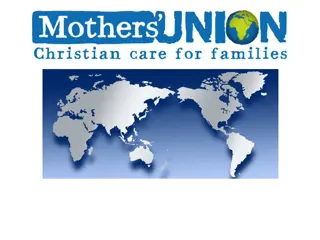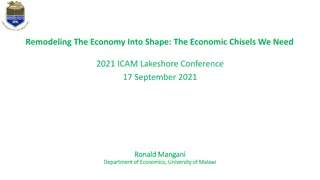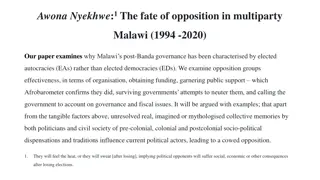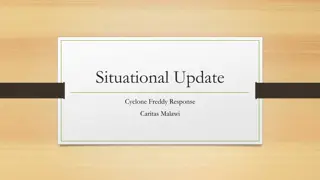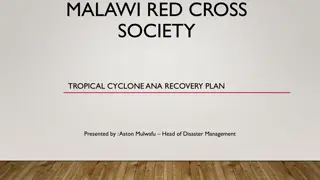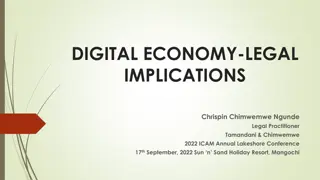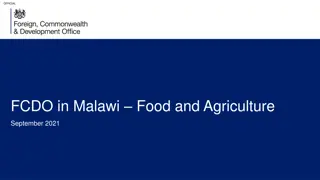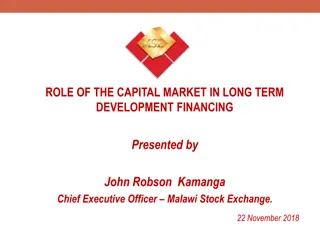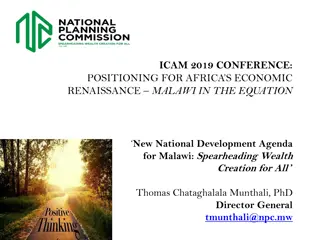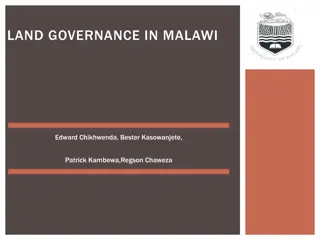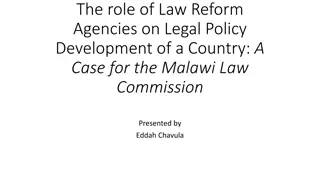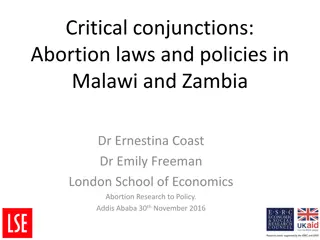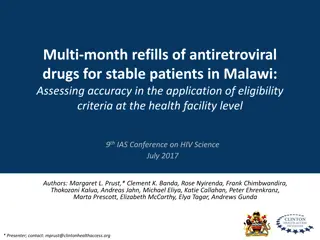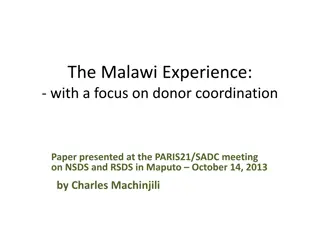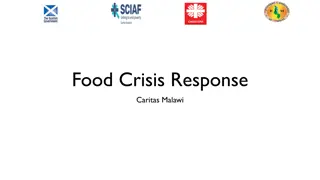Reflections and Thoughts on Development Planning in Malawi
This paper explores development planning in Malawi as discussed at the ECAMA Annual Conference in 2017. It delves into the challenges, strategies, and visions for transformative and inclusive economic development in the region.
Download Presentation

Please find below an Image/Link to download the presentation.
The content on the website is provided AS IS for your information and personal use only. It may not be sold, licensed, or shared on other websites without obtaining consent from the author.If you encounter any issues during the download, it is possible that the publisher has removed the file from their server.
You are allowed to download the files provided on this website for personal or commercial use, subject to the condition that they are used lawfully. All files are the property of their respective owners.
The content on the website is provided AS IS for your information and personal use only. It may not be sold, licensed, or shared on other websites without obtaining consent from the author.
E N D
Presentation Transcript
Reflections and Thoughts on Development Planning in Malawi Ephraim W. Chirwa ECAMA Annual Conference on Rethinking Pillars and Structures for Malawi s Transformative and Inclusive Economic Development , 9th 10th October 2017, Sunbird Nkopola, Mangochi
Chatham House Rule When a meeting, or part thereof, is held under the Chatham House Rule, participants are free to use the information received, but neither the identity nor the affiliation of the speaker(s), nor that of any other participant, may be revealed. 2
Outline Context of Development Planning in Malawi Key Shortfalls Key Areas for Inclusive Economic Development 50 Years After Independence: We Must be Ashamed!! Conclusion 3
Ideological Context of Development Approaches Nationalist ideologies of state-led development 1960s State investment in public and private goods Central planning for large infrastructure investments State-owned companies Structuralism of the 1970s Guided markets Active state involvement and controls in economic activities Development and economic policies vital Neoclassical/Washington Consensus Trust markets Development policies aimed at economic re-orientation Post-Washington Consensus Proliferation of development strategy documents to address specific development problems 4
Ideological Shifts Over Time? Nationalist ideologies of state-led development 1960s Markets do not function well and central planning critical for development Nationalist ideologies dominated in immediate post- Independence era Malawi - more articulate development plans focused on investing in basic development conditions: education, health and infrastructure First Development Plans 1962 -1965 Second Development Plans 1965 1969 Creation of MDC to invest in private goods Key investments: Lake shore road, airports, National University 5
Ideological Shifts over Time? Structuralism in the 1970s Markets do not function well and development has to be guided Development policies were fashionable This is the period Malawi had its First Statement of Development Policies 1971 - 1979 Highlights of limited large investments Key investments: Salima - Mchinji rail construction, relocation of capital city from Zomba to Lilongwe 6
Ideological Shifts over Time? Neoclassical /Washington consensus, in 1980s & 1990s Markets should be allowed to play critical role in development Policies for structural reforms, from plans to policies This is the period Malawi had its Second Statement of Development Policies 1987 - 1996 Limited central planning 7
Ideological Shifts over Time? Post-Washington Consensus, 2000 to date Markets should be allowed to play critical role in development Millennium/Social Development Goals to deal with social development Develop strategies to deal with losers in policy reforms This is the period Malawi had produced 6 development strategies Limited central planning and large investments driven by political party manifestos 8
Key Development Plans, Policies and Strategies 1 Document Name First Development Plan 1962 - 1965 Content Development Plans Duration 1961 1964 (4 years) Key Issues Road infrastructure Human capital education and health infrastructure Key investments listed and prioritised Construction of roads and rail infrastructure Improvement of airports Human capital education (including higher education) and health infrastructure Establishing a Development Corporation (institutions) Basic policies to support development plans 2 Second Development Plan 1965 - 1969 Development Plans 1965 1969 (4 years) 3 Statement of Development Policies 1971 1980 (DEVPOL I) Statement of Development Policies 1987-1996 (DEVPOL II) Malawi Vision 2020 Policy Document 1971 1980 (10 years) 1987-1996 (10 years) 2000 2020 (20 years) 2002 2005 (4 years) (2003) 2004 - undefined 2005 2015 (10 years) (2005) 2006 -2011 (5 years) Economic policy reforms to a market system Divestiture of state activities in private goods sectors Development aspirations to be middle income country by 2020 Externally driven to address social development focussing on the poor lost in the reform process Pro-poor sustainable growth Internally driven private sector-led development focusing on large scale businesses Internationally driven to address human and social development Poverty reduction sustained growth and infrastructure development 4 Policy Document 5 Aspirations Document 6 Malawi Poverty Reduction Strategy (MPRS) Strategy Document with some policies 7 Malawi Economic Growth Strategy (MEGS) Millennium Development Goals Strategy Document 8 Strategy Document 9 Malawi Growth and Development Strategy (MGDS I) Strategy Document with mix of policies & undefined plans & many focal areas Strategy Document with mix of policies & undefined plans & many focal areas More of the same - Poverty reduction sustained growth and infrastructure development 10 Malawi Growth and Development Strategy (MGDS II) (2010) 2011 2016 (5 years) 9
Key Shortfalls Poor designs - too many focal areas and undefined public investments in strategy documents Human capital development - fragmented investments in education and health Poor implementation and mismatch of resources (resulting in part from poor designs and weak institutions) 10
Key Shortfalls Limited monitoring and evaluation and perverse learning from experiences tend to learn bad things New strategies drawn before full implementation of previous ones New strategies drawn without proper independent evaluation of previous ones internal evaluations full of self-praise In MGDS II It follows the successful implementation of the country s medium term strategy, the Malawi Growth and Development Strategy (MGDS) between 2006 and 2011 Celebrating micro achievements FISP implementation classic example of technocrats and elites failing the poor 11
Public Sector: Uplifts of Fertilisers to Markets Late uplift of fertilisers to markets and 2015/16 show worst performance Deteriorating trend from 2010/11 - the public system (bureaucrats) failing the poor A classic case of perverse learning by doing 12
Key Shortfalls Proliferation of rent-seeking activities at national, district and local levels Weak institutions captured by the political and technical elites Political party manifesto driven public investments and development 13
Inclusive Economic Development Long-term plans with well defined and identifiable rolling investments in key basic conditions of development Politics should work towards fulfilling such investments Human capital development should be at the centre of development plans Development plans should focus on public investments in public goods 14
Three Focal Areas for Inclusive Development Education Infrastructure and matching manpower development Planning Question: If we want 90% of our primary school learners to transition into completing secondary education in 20 years time, what kind of investments do we need? We should be asking similar questions about secondary to tertiary levels. Health (including water) Infrastructure and matching manpower development Transport Infrastructure roads and rail to facilitate mobility Energy? 15
50 Years After Independence: We Must Be Ashamed! We train nurses, clinicians and medical doctors and they have to beg to be employed and deployed to health facilities!! A Norwegian is worried (The Nation, 7 November 2017). What about us here as planners? 16
50 Years After Independence: We Must Be Ashamed! Are these tobacco sheds? NO, this is a primary school in Mchinji, photo taken in May 2016. Let us ensure that no one learns in such environments! 17
50 Years After Independence: We Must Be Ashamed! This is a primary school in Nsanje, photo taken in May 2016. That man standing deserve better pay and conditions of service! 18
50 Years After Independence: We Must Be Ashamed! This is my team of researchers going to primary school in Nkhata Bay, photo taken in July 2016. Impassable road by car, fortunately no crocodiles in the waters!!! Without road infrastructure, how do we deliver materials to this school? How do we inspect this school to ensure quality education? 19
Conclusions Inclusive economic development will be difficult to achieve without human capital development An inter-modal transport infrastructure is key in supporting human capital mobility 20
Reflections and Thoughts on Development Planning in Malawi Ephraim W. Chirwa ECAMA Annual Conference on Rethinking Pillars and Structures for Malawi s Transformative and Inclusive Economic Development , 9th 10th October 2017, Sunbird Nkopola, Mangochi


